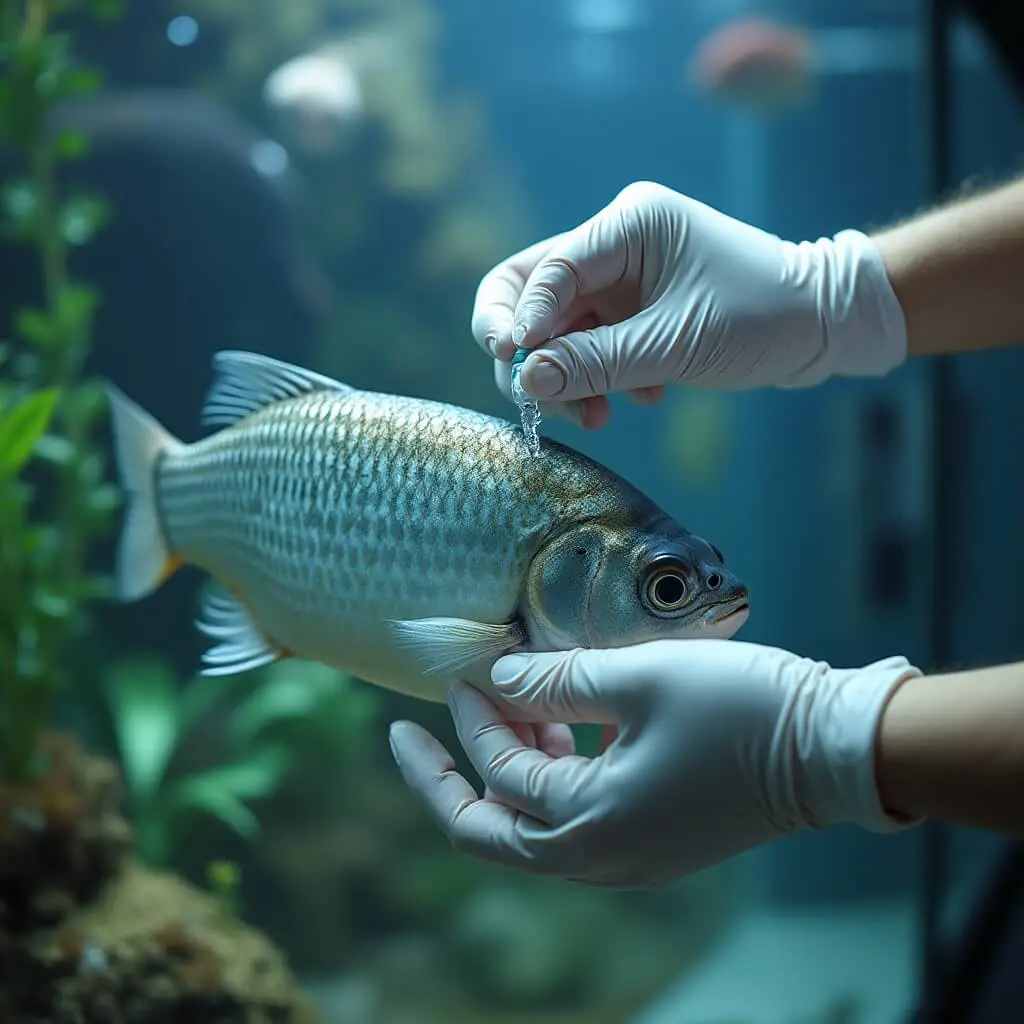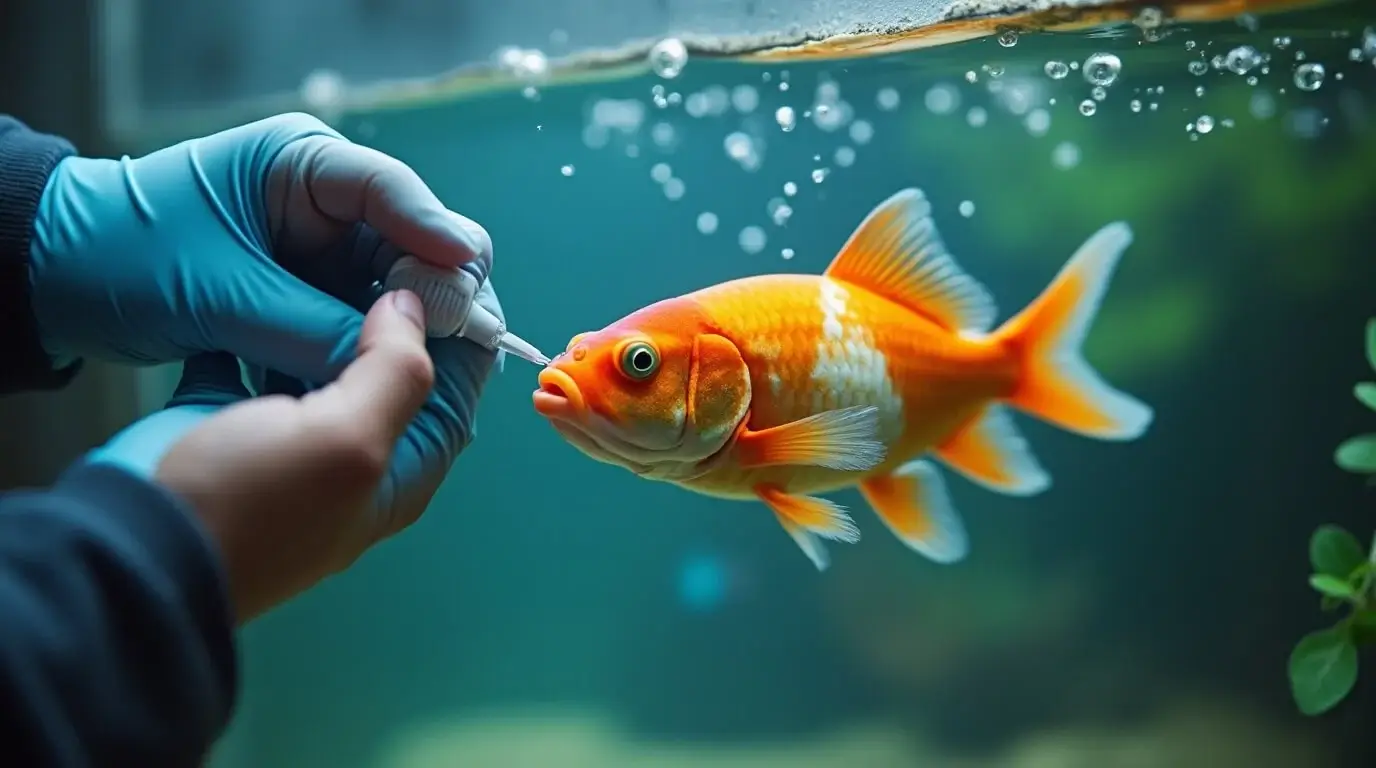Table of Contents
Antibiotics are vital tools in fighting bacterial infections, not just for humans but for animals too. Among these, fish antibiotics have gained attention for their role in treating infections in aquarium fish. Sold under names like Fish Mox, these medications are specifically designed to combat bacterial diseases in fish, ensuring their health and well-being in aquatic environments.
One of the most commonly used antibiotics in this category is amoxicillin, a broad-spectrum antibiotic effective against a range of bacterial infections. In veterinary use, it targets diseases like fin rot and bacterial gill disease, ensuring a healthy ecosystem in aquariums. While amoxicillin is a staple in human medicine for treating ear infections, pneumonia, and more, its inclusion in fish antibiotics has opened a controversial dialogue.
Recently, there has been a growing trend of people considering or even using fish antibiotics, like Fish Mox, as substitutes for prescribed human medications. This trend stems from factors like the affordability, easy accessibility, and lack of prescription requirements for fish antibiotics. However, the risks associated with such self-medication practices raise significant concerns about safety, legality, and public health implications.
Key Takeaways
- Fish antibiotics are designed for aquatic animals, not humans.
Medications like Fish Mox are specifically formulated and marketed to treat bacterial infections in fish and are not approved by the FDA for human consumption. - Self-medicating with fish antibiotics poses serious risks.
Misdiagnosis, improper dosing, and lack of quality control can lead to worsened health issues, allergic reactions, or exposure to contaminants. - Using fish antibiotics can contribute to antibiotic resistance.
Misuse of antibiotics increases the likelihood of bacteria developing resistance, leading to harder-to-treat infections and a significant public health threat. - Consulting healthcare professionals ensures safe and effective treatment.
Licensed medical providers can diagnose illnesses accurately and prescribe FDA-approved medications tailored to human needs, safeguarding health and minimizing risks. - Affordable healthcare resources are available.
Programs like low-cost clinics, prescription assistance programs, and telehealth services offer accessible options for obtaining proper medical care and human-grade medications. - Education is key to preventing antibiotic misuse.
Raising awareness about the dangers of self-medicating with non-human antibiotics helps protect individual and public health while combating the spread of superbugs.
How Fish Amoxicillin Is Marketed and Sold
Availability of Fish Antibiotics Online and in Stores
Fish antibiotics, including popular brands like Fish Mox, are widely available both online and in physical stores that cater to pet owners. Retailers like pet supply shops, aquarium specialty stores, and large online marketplaces such as Amazon and eBay commonly stock these products. They are often sold in easily recognizable packaging, clearly labeled for aquarium use. This accessibility makes them an appealing option for hobbyists looking to maintain the health of their fish without needing to consult a veterinarian.
Regulatory Oversight by the FDA
The Food and Drug Administration (FDA) regulates medications for both humans and animals, ensuring their safety, effectiveness, and proper labeling. Fish antibiotics fall under the category of veterinary products, and their intended use is specifically for treating diseases in aquatic animals. However, the FDA does not evaluate or approve fish antibiotics for human consumption. As these products are marketed solely for use in fish, they bypass the stringent standards required for human-grade medications.
While the FDA emphasizes the importance of using antibiotics as directed and only under veterinary or medical supervision, the lack of enforcement in certain retail spaces contributes to the misuse of these products.
Why They’re Accessible Without a Prescription
One of the primary reasons fish antibiotics like Fish Mox are so readily available is their classification as over-the-counter veterinary products. Since fish antibiotics are not intended for human consumption, manufacturers are not required to impose the same restrictions as those placed on human medications. This means consumers can purchase them without prescriptions, making them more accessible than their human-grade counterparts.
Additionally, the marketing of fish antibiotics focuses on their use in aquariums, which allows them to circumvent the tighter regulations applied to medicines intended for humans or larger animals like cats and dogs. This easy access, combined with a lack of awareness about the risks of misuse, has led to the growing trend of individuals using fish antibiotics for self-medication, despite the associated dangers and potential legal implications.
The Dangers of Using Fish Antibiotics for Humans
Risk of Misdiagnosis and Self-Medication
Self-medicating with fish antibiotics can pose serious risks, primarily because it bypasses professional medical evaluation and diagnosis. Antibiotics like amoxicillin are effective only against bacterial infections, but many common ailments are caused by viruses, fungi, or other non-bacterial factors. Without proper testing and medical expertise, individuals may incorrectly identify their condition, leading to ineffective treatment or worsening of symptoms.
Moreover, inappropriate use of antibiotics can mask underlying health conditions, delaying accurate diagnoses and proper medical care. For instance, symptoms treated with amoxicillin might actually indicate a more serious issue requiring different treatment. Self-diagnosis and medication could lead to complications, prolonged illness, or even life-threatening situations.


Lack of Quality Control in Non-Human Antibiotics
Fish antibiotics are manufactured and labeled explicitly for veterinary use, which means they are not subjected to the rigorous quality control processes that apply to human medications. While these products may contain the same active ingredients as their human-grade counterparts, their purity, potency, and formulation are not guaranteed to meet the standards set by the Food and Drug Administration (FDA) for medications intended for human use.
Non-human antibiotics may also lack safeguards against contamination during manufacturing. For humans, this can increase the risk of adverse effects, allergic reactions, or exposure to harmful substances. Additionally, dosage instructions on fish antibiotics are tailored for aquatic animals, leaving users to guess the appropriate amount, which can lead to underdosing or overdosing—both of which have serious consequences.
Antibiotic Resistance and Its Long-Term Impact
One of the most concerning dangers of misusing fish antibiotics is their role in contributing to antibiotic resistance. When antibiotics are used improperly—such as at incorrect dosages or for conditions they cannot treat—they fail to completely eliminate harmful bacteria. This allows the surviving bacteria to adapt and develop resistance to the drug, rendering it ineffective in future treatments.
The rise of antibiotic-resistant bacteria, or “superbugs,” is a global public health crisis. These resistant strains are harder to treat, require stronger and more expensive medications, and increase the risk of severe illness and death. Misuse of antibiotics by self-medicating individuals accelerates this issue, not only putting their own health at risk but also contributing to a broader societal problem that endangers others.
Legal and Ethical Considerations
Are Fish Antibiotics Legal for Human Use?
Using fish antibiotics like Fish Mox for human consumption raises significant legal concerns. These products are explicitly labeled and marketed for veterinary use, meaning they are not approved by the Food and Drug Administration (FDA) for human consumption. The FDA regulates medications to ensure safety and efficacy, and consuming products intended for animals can violate federal laws, especially if done knowingly and in ways that risk public health.
Moreover, the packaging of fish antibiotics often includes disclaimers stating that they are “not for human use.” Ignoring these warnings could lead to legal repercussions, particularly if such actions result in harm to oneself or others. While the purchase of fish antibiotics is not inherently illegal due to their veterinary classification, their off-label use in humans skirts the boundaries of ethical and legal acceptability.
Ethical Concerns About Self-Prescribing Antibiotics
From an ethical perspective, bypassing healthcare professionals to self-prescribe antibiotics is problematic. Medical professionals possess the training and tools necessary to diagnose conditions accurately and prescribe appropriate treatments. By choosing to self-medicate with fish antibiotics, individuals undermine the role of these experts, potentially putting themselves and others at risk.
Additionally, the misuse of antibiotics contributes to the growing crisis of antibiotic resistance, a public health issue that affects communities worldwide. Using fish antibiotics irresponsibly exacerbates this problem, making effective treatments less accessible for those who genuinely need them. This raises ethical questions about personal accountability and the broader societal implications of such behavior.
What Veterinarians Say About the Trend
Veterinarians are increasingly voicing concerns over the misuse of pet medications, including fish antibiotics, by humans. Many experts emphasize that these products are tailored specifically for animals, with differences in formulation, dosage, and intended use. The assumption that fish antibiotics are interchangeable with human medications is a dangerous oversimplification.
Veterinarians also highlight the risks associated with improper storage and handling of pet antibiotics, which may compromise their quality and efficacy. They stress the importance of seeking professional advice when dealing with health concerns rather than resorting to unregulated or non-human-grade medications. Some veterinarians have even called for tighter regulations on the sale of fish antibiotics to prevent their misuse.
Safer Alternatives and Best Practices
Consulting a Healthcare Provider for Proper Treatment
When it comes to treating infections or other health issues, there is no substitute for professional medical advice. Healthcare providers possess the expertise and diagnostic tools necessary to identify the root cause of an illness and prescribe the most effective treatment. Relying on self-medication with fish antibiotics bypasses this critical step, potentially leading to incorrect treatment and complications. Consulting a doctor ensures that the appropriate medication, dosage, and duration are tailored to your specific condition, safeguarding your health and well-being.
Using FDA-Approved Medications for Humans
FDA-approved medications are subjected to rigorous testing and strict regulations to ensure their safety, efficacy, and quality for human use. Unlike fish antibiotics, which are designed for veterinary purposes, human-grade antibiotics are formulated and dosed specifically for human physiology. By using medications prescribed by a healthcare provider, you benefit from proper oversight and support, minimizing the risk of adverse effects, contamination, or incorrect dosing. Choosing regulated medications ensures that your treatment meets the highest standards of medical care.
The Role of Education in Preventing Antibiotic Misuse
Education plays a vital role in addressing the dangers of antibiotic misuse. Public awareness campaigns can highlight the risks of self-medicating with fish antibiotics, including the potential for antibiotic resistance and health complications. These initiatives should also emphasize the importance of consulting healthcare professionals and adhering to prescribed treatments.
Communities, schools, and healthcare organizations can collaborate to disseminate accurate information about antibiotics, helping individuals make informed decisions. By promoting responsible use and discouraging misconceptions, such educational efforts can significantly reduce the prevalence of improper antibiotic usage.
Resources for Affordable Healthcare
One of the primary reasons individuals turn to fish antibiotics is the perceived affordability compared to human medications. However, there are numerous resources available to make healthcare more accessible and cost-effective.
- Low-Cost Clinics: Federally Qualified Health Centers (FQHCs) and community clinics often provide sliding-scale fees based on income, ensuring affordable care for those in need.
- Prescription Assistance Programs: Organizations like NeedyMeds and RxAssist offer programs to help individuals access medications at reduced costs.
- Telehealth Services: Online consultations with licensed healthcare providers can offer convenient and often lower-cost medical advice and prescriptions.
- Non-Profit Organizations: Groups like the Patient Advocate Foundation assist with financial support for medical treatments and medications.
By utilizing these resources, individuals can obtain proper medical care and avoid the risks associated with self-medicating with fish antibiotics.
Conclusion
The use of fish antibiotics like amoxicillin for human self-medication might seem like an easy or affordable solution, but it comes with significant risks and legal concerns. Misdiagnosing an illness and self-prescribing non-human medications can worsen medical conditions, lead to improper dosing, and contribute to the alarming rise of antibiotic resistance. Moreover, the lack of quality control in fish antibiotics and their explicit designation for veterinary use highlight the legal and health hazards associated with their misuse.
Consulting a healthcare professional is the safest and most effective way to address medical issues. Doctors and licensed medical providers have the expertise to diagnose conditions accurately and prescribe appropriate, FDA-approved medications tailored to human needs. This approach not only ensures better treatment outcomes but also minimizes the risks to personal and public health.
As antibiotic resistance becomes an ever-growing threat to global health, it is crucial to use antibiotics responsibly. Avoid self-medication, adhere to prescribed treatments, and support education on the dangers of misuse. Together, these actions can help preserve the effectiveness of antibiotics for future generations. Let’s make informed choices to protect both our health and the health of our communities.
References
- Eugenia Popescu Roberts, Charles Veltri, Maria Lozoya, Gina Agostini-Walesch MA, John C. Mitchell, Nonprescription fish antibiotics:: Are they the same as those prescribed to humans?, JADA Foundational Science, Volume 1, 2022, 100015. https://doi.org/10.1016/j.jfscie.2022.100015.
- Food and Agriculture Organization, Residue Monograph prepared by the meeting of the Joint FAO/WHO Expert
Committee on Food Additives (JECFA), 85th Meeting 2017. https://openknowledge.fao.org. - Zhang W, Williams A, Griffith N, Gaskins J, Bookstaver PB. Online availability of fish antibiotics and documented intent for self-medication. PLoS One. 2020 Sep 3;15(9):e0238538. doi: 10.1371/journal.pone.0238538. PMID: 32881969; PMCID: PMC7470343.
FAQ: Fish Antibiotics Amoxicillin – Is It Really Safe?
1. What are fish antibiotics, and why are they used?
Fish antibiotics, such as amoxicillin (commonly sold under the name Fish Mox), are medications formulated to treat bacterial infections in fish. They are used to maintain the health of aquarium fish by combating diseases like fin rot or bacterial gill infections.
2. Can humans safely use fish antibiotics like amoxicillin?
No, fish antibiotics are not approved for human consumption. While they may contain similar active ingredients to human antibiotics, they are not manufactured to the same safety and quality standards required for human medications. Using them can pose significant health risks, including improper dosing, contamination, and exacerbating medical conditions.
3. Why are fish antibiotics available without a prescription?
Fish antibiotics are classified as veterinary products and are marketed specifically for aquarium use. Since they are not intended for humans, they are not subject to the same prescription requirements as human medications. This makes them more accessible in pet stores and online.
4. What are the dangers of using fish antibiotics for humans?
Using fish antibiotics can lead to several risks, including:
- Misdiagnosis and incorrect treatment.
- Inaccurate dosing due to lack of professional guidance.
- Exposure to contaminants or substandard formulations.
- Contributing to antibiotic resistance, a global public health issue.
5. Are fish antibiotics illegal for human use?
While purchasing fish antibiotics is not illegal, using them for human consumption may violate federal regulations, particularly if it results in harm or undermines public health. These products are labeled as “not for human use,” and ignoring such warnings can have legal and medical consequences.
6. How do fish antibiotics differ from human antibiotics?
Fish antibiotics are designed for aquatic animals, and their manufacturing process does not meet the stringent quality and purity standards required for human-grade medications. They may also lack critical safeguards against contamination or incorrect formulations.
7. What are safer alternatives to fish antibiotics for humans?
Safer alternatives include consulting a licensed healthcare provider to receive:
- Accurate diagnoses.
- FDA-approved antibiotics prescribed for your specific condition.
- Professional guidance on dosing and potential side effects.
8. What resources are available for affordable healthcare and medications?
If cost is a concern, consider the following options:
- Community Clinics: Offer sliding-scale fees based on income.
- Prescription Assistance Programs: Nonprofits like NeedyMeds provide medication discounts.
- Telehealth Services: Often more affordable than in-person visits.
- State and Local Programs: Many areas offer subsidized healthcare services for low-income individuals.
9. How can using fish antibiotics contribute to antibiotic resistance?
When antibiotics are misused—such as taking incorrect doses or using them for non-bacterial illnesses—they may fail to eliminate harmful bacteria. These surviving bacteria can develop resistance, making future infections harder to treat and threatening public health globally.
10. What should I do if I have already used fish antibiotics?
If you have used fish antibiotics, it’s important to consult a healthcare provider immediately. They can assess your condition, provide appropriate treatment, and address any potential side effects or complications.
